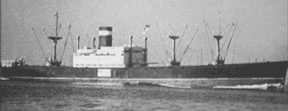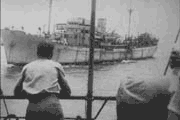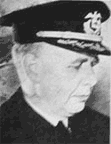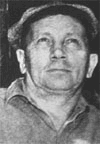The Dreadful Saga of the MV American Leader and Her Crew
by Captain George Duffy
MV American Leader
The MV American Leader was a C1-B motorship built by Western Pipe and Steel at Richmond, California, and delivered to the American Pioneer Line division of United States Lines in mid-1941. Her maiden voyage took her to the Far East, then New York, where a new crew came aboard in September 1941.
I, five months past my 19th birthday, and recently graduated from the Massachusetts Nautical School, became the vessel's Junior Third Officer in charge of the 8 to 12 bridge watch. After loading the usual cargo of canned goods, tobacco, paint, automobiles, etc. in several East Coast ports, we went through the Panama Canal on our way to Manila, Hong Kong, and Shanghai. We stopped at Wilmington, California to take on mail, magazines, and several large underground fuel tanks for the United States Army Air Force in the Philippines.
[George Duffy, 1941 photo]
On December 8, 1941, the MV American Leader was laying alongside Pier 2 in Manila when the Japanese attacked Pearl Harbor. Two days later we witnessed the bombing of ships in Manila Bay and the air attack that destroyed the United States Naval Base at Cavite. On the 11th, the Navy told Captain Haakon A. Pedersen to leave, which we did that evening. Christmas Day saw us safely in Sydney, Australia, and on March 17, 1942 we arrived in Boston with some of the first eyewitness accounts of the Far East war.
Six weeks later, with an ancient 4-inch cannon on our stern, plus four machine guns -- two of which never fired one round without jamming -- manned by a Naval Reserve Ensign and 8 enlisted men, we departed New York. In the interval I had been promoted to the 12 to 4 watch.
Our cargo consisted of war supplies for Russia and Great Britain. Lashed on deck were nine twin-engine bombers; in the holds were thousands of tons of boots, barbed wire, vehicles, and so forth, all to be delivered to the Russians at Persian Gulf ports. Several thousand tons of steel ingots were destined for India.
August found the American Leader in Colombo, Ceylon (now Sri Lanka) loading cargo for the United States. Hundreds of thousands of bales of raw rubber went into the hatches, the cargo tanks were filled with liquid latex, and huge barrels of the same white, sticky stuff were lashed to the weather deck. In Iran and Iraq we took on rugs, chemicals, and other raw materials.
The southwestward run across the Indian Ocean was lonely and uneventful. We traveled alone, as we had since fleeing Manila. No convoy, no escorts, no air cover. At Capetown on September 7, routing orders were received from the British Admiralty. Instead of heading north in convoy, which was our fervent desire, the American Leader was sent westward to the Straits of Magellan and the Pacific.
[American Leader crew in messroom]
In the meantime, since March 26, the disguised Hilfskreuzer (auxiliary cruiser) Michel of the Deutsche Kriegsmarine (German Navy) had been operating in the South Atlantic with impunity. Carrying six 15 cm (5.9 inch) and one 10 cm (4.1 inch) cannons, above- and below-water torpedo tubes, an 11-ton torpedo boat, two scouting aircraft, and several 37 mm and 20 mm rapid fire guns, this was an extremely dangerous adversary.
Built as a merchant vessel in Poland and taken in the September 1939 occupation by Germany, she looked like a merchant ship. Five merchant captains (Kriegsmarine reservists) were aboard for the purpose of taking captured Allied ships to Europe, and to insure that her outward appearance was that of a merchantman in spite of her hidden armament and large, uniformed crew.
[photo of German Raider Michel at right]
Prior to September 10, nine Allied ships had fallen prey to the Michel, and on that dark night the American Leader became the 10 th. Following the sinking, the Michel returned to the scene. From three liferafts, 47 survivors were picked up and taken prisoner. Eleven men were lost.
We found three American seamen on board the Michel. They had been badly wounded in the sinking of their empty tanker, the SS William F. Humphrey on July 16. Other survivors were transferred to a German supply ship during August.
Two nights later, the Michel caught the British motorship Empire Dawn, in ballast from Suez to the Caribbean. Of her 44 man crew, 25 were rescued, but 3 died on board the Michel. In late September, the raider met two supply ships. The first was the blockade runner Tannenfels, homeward bound from the Far East, which provided much needed fresh provisions. The second was the large (22,000 deadweight tons) Kriegsmarine Trossschiffe (Navy replenishment vessel) Uckermark with ammunition, fuel, spare parts, mail, and food. On October 7, the 72 prisoners were transferred to the Uckermark.The following day the two German ships parted company, and we were headed to the Japanese occupied Far East where on November 6, at Batavia, Java, the Germans handed us over. For six months we were lodged in a military prisoner-of-war camp populated by British, Dutch, and Australian troops, then moved to another camp for six weeks or so. After that we were separated, but all remained on Java for well over a year.
The first to leave was Captain Pedersen, who was taken to Formosa, and then to Mukden, Manchuria from where he was repatriated at the end of the fighting. In April 1944, the Japanese selected about 1,000 prisoners, including 18 American Leader survivors, to be sent to Japan. They were taken by a small coastal freighter to Singapore where they were transferred to a large ocean-going vessel for the trip north. Just before midnight on June 26, approaching Nagasaki in a heavily escorted convoy, their ship, the Tomahaku Maru, [sometimes spelled Tamahoko] was torpedoed by the USS Tang.
5 of the 18 American Leader crew survived and were repatriated from Kyushu in 1945.
On that same day, another 1,200 prisoners embarked at Batavia in the small Chukka Maru for neighboring Sumatra via Singapore to build a railway across that island. With this group were 6 American Leader crew including myself.On September 15, the ancient coal-burning Junyo Maru left Batavia carrying the almost unbelievable total of 2,300 Allied prisoners, 4,200 conscripted Javanese laborers, and hundreds of Japanese, including the ship's crew and the guard detail. In the late afternoon of the 18th, in the Indian Ocean, 14 miles off the Sumatran coast, the Junyo Maru was hit by two torpedoes from HMS Tradewind. Most of the Javanese drowned, as did more than 1,500 of the prisoners.
Of the 9 American Leader personnel aboard the Junyo Maru, 5 survived.
Of the two groups that reached Sumatra, one man from each did not survive, succumbing to the combination of malaria, malnutrition, and overwork.
When the fighting came to an end, American Leader survivors were scattered throughout the Far East. Captain Pedersen was in Manchuria. On Kyushu were 5 men, on Sumatra 9, and still on Java, 13. Of the 58 American merchant seamen and Naval Armed Guard who left New York in April 1942, only 28 returned home.





